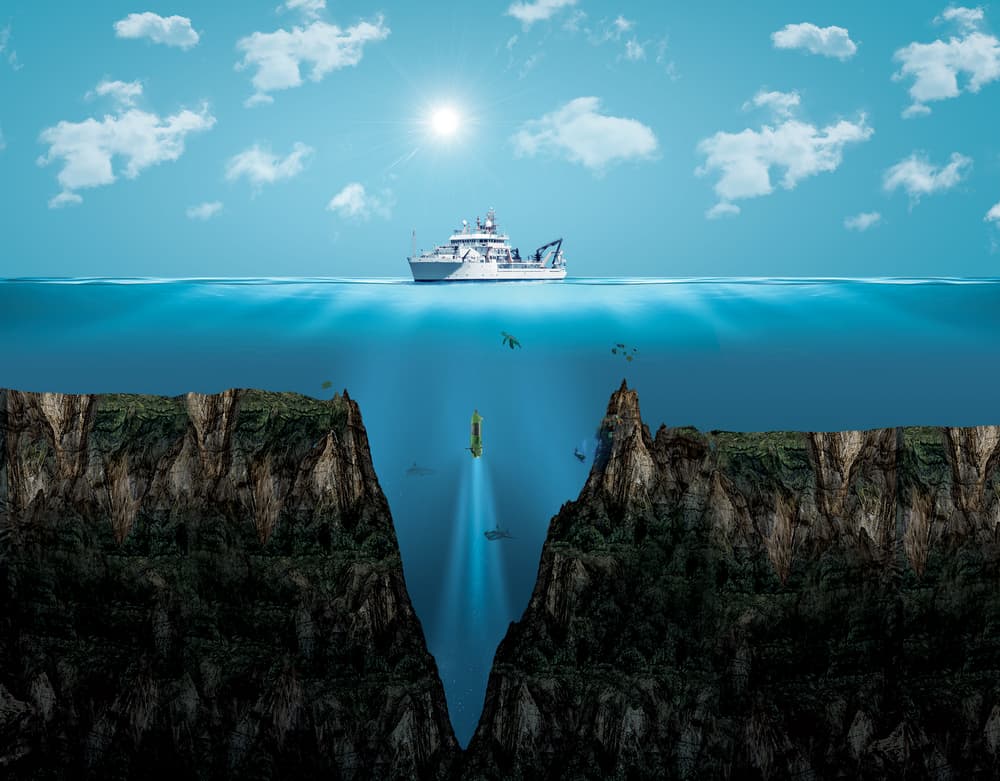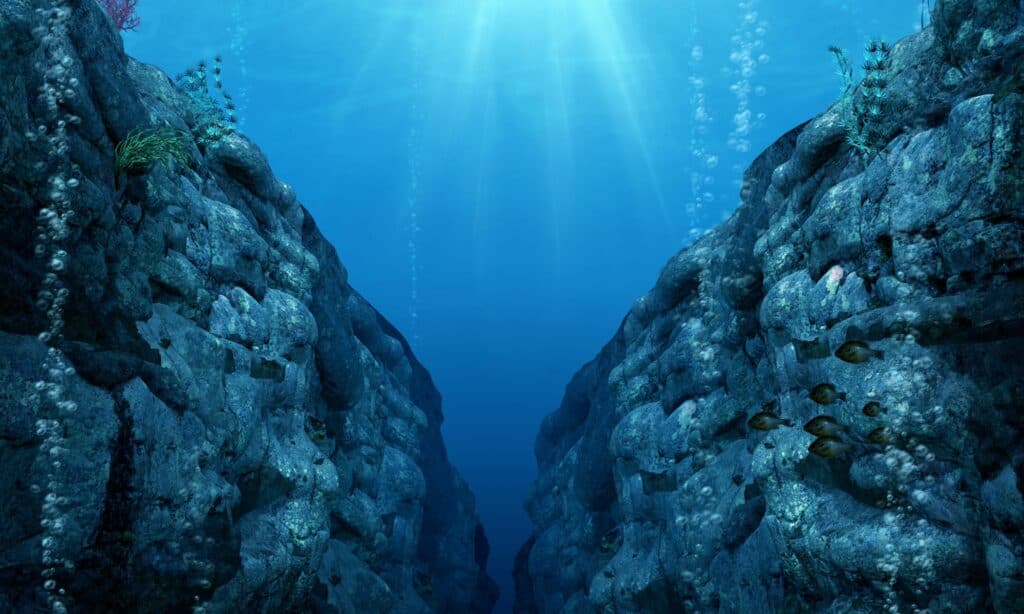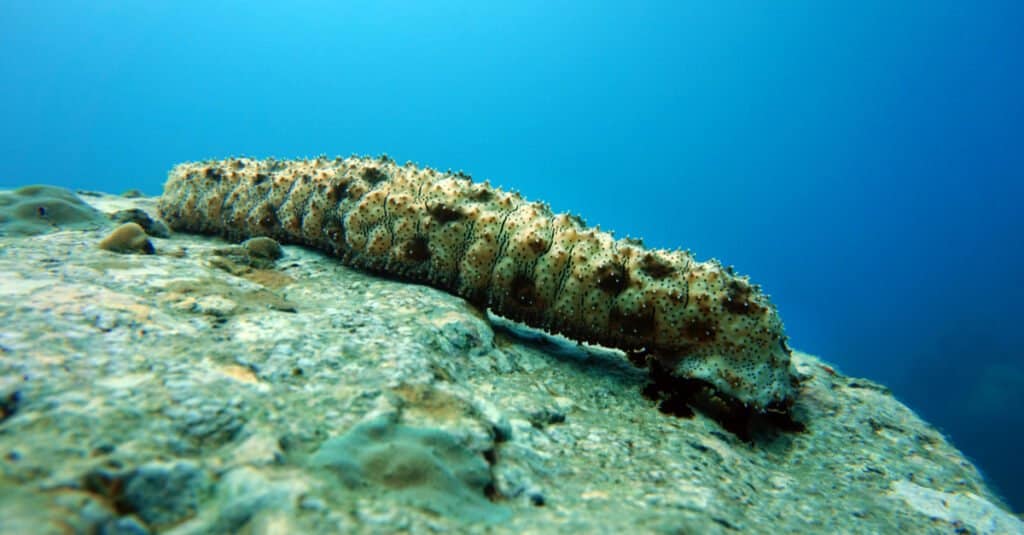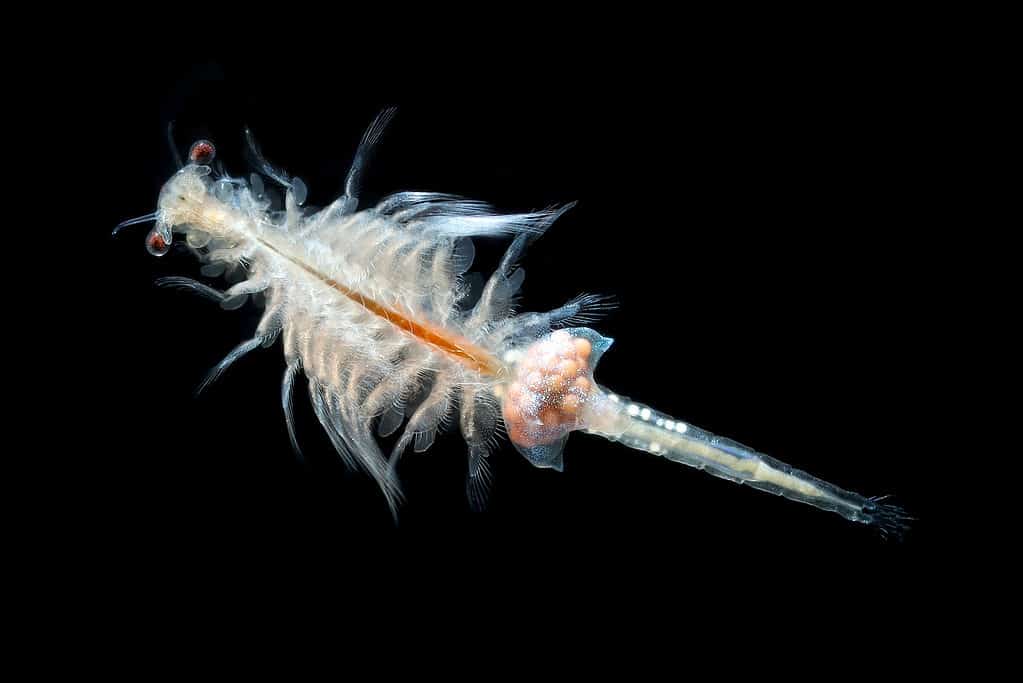Imagine a vast, seemingly endless, pitch-black hole filled with seawater and unknown creatures. You’re not alone if it’s making you panicky just thinking about it. There is a reason why only a few people have dared to go to the deepest part of the earth: it’s uninhabitable to humans and most animals.
Have you ever wondered what lives at the bottom of the Challenger Deep? While we have some answers, without continuous research, there is no telling what undiscovered species may lurk in these depths. Find out what these limited expeditions uncovered and what scientists learned about the deepest trench on the planet.

What is the Challenger Deep?
The Challenger Deep is the deepest known point in the earth’s crust. It lies within the southern end of the Mariana Trench (the deepest trench on earth) in the Western Pacific Ocean. The Mariana Trench is a crescent-shaped oceanic trench, and the Challenger Deep is a slot-shaped depression on the bottom of this trench. Its description consists of an elongated seabed with three distinct sediment-filled pools. The deepest part recorded was 35,827 feet, almost seven miles below the ocean’s surface.

The Challenger Deep, within the Mariana Trench, is the deepest point on earth. It is 35,827 feet deep.
©DOERS/Shutterstock.com
Who Discovered it?
From 1872 to 1876, a scientific program laid the foundation of oceanography. It made remarkable discoveries about our planet. Challenger Deep was named after the HMS Challenger, a British Royal Navy survey ship.
This expedition was the first to discover the Mariana Trench, just 15 miles from the Challenger Deep. Pioneers aboard the ship happened by chance upon the area near Guam. They used a weighted rope to conduct “soundings” and measured the depth of the sea floor.
The first time humans ventured to the deep was in 1960. During this time, NASA sent people to space, and oceanographers decided to conquer the last natural frontier. Their mission was successful, and they spotted the very first signs of life at a depth of this magnitude. Scientists were unsure if creatures could survive this deep, but these pioneers confirmed that life always finds a way.
Now that you know who first discovered the trench, let’s discuss why the Challenger is so deep and if anything on the earth is deeper.
Why is the Challenger Deep so Deep?

The Mariana Trench is deeper on its southern end due to a tear in the subducting plate.
©iStock.com/ratpack223
The Challenger Deep is so exceptionally profound that you could fit five Grand canyons from the surface to the cavern floor or 13 of the tallest building in the world stacked from end to end. As humans, that’s hard to fathom. It took five hours for the first vessel in 1960 to sink to the bottom!
Subduction, the process of one tectonic plate drilling over the top of another, caused the Mariana Trench’s formation. Scientists confirmed seismic evidence of a tear in the subducting plate, which causes a deformation of the overriding plate. This tear caused greater depths along the southern end of the Mariana Trench, right where the Challenger Deep sits. A survey (2003) of part of the ocean floor speculates another deep may rival the Challenger.
Is There Anything Deeper?
The Horizon Deep in the Tonga Trench in the Southwestern Pacific Ocean is 35,433 feet deep, making it the second deepest trench in the world by less than 400 feet. The third deepest is the Sirena Deep, also in the Mariana Trench. The Sirena Deep measures 35,151 feet and is approximately 120 miles east of the Challenger Deep.
What Lives at the Bottom of Challenger Deep?

Sea cucumbers live at the bottom of the Challenger Deep.
©Natalia Siiatovskaia/Shutterstock.com
Microorganisms, shrimp, marine worms, and sea cucumbers live at the bottom of the Challenger Deep.

Polychaete worms can be found at the bottom of Challenger Deep.
©Anton Peichev/Shutterstock.com
In 1960, when scientists descended to the depths of the hadal realm, they noted that this may be the first light to ever pierce through the darkness. Their light beams illuminated diatomaceous ooze on the sea floor and a type of flatfish they believed to be a highly evolved invertebrate. Scientists later disputed this theory and thought the explorers were most likely seeing a sea cucumber.

Shrimp can be found at the bottom of Challenger Deep.
©Dan Olsen/Shutterstock.com
While you may feel disappointed (or relieved) to know no giant sea monsters are swimming in these trenches, there have only been a few expeditions to these far-reaching places in the earth’s crust. Robotic probes were lowered to the Challenger Deep throughout the years to bring back specimens. Their findings included scale worms, shrimp, microorganisms, and polychaeta worms.
One of the fascinating discoveries of the deep is the seeps in the sea floor. These seeps are in the rocks where water is heated by chemical reactions and bubbles up into the ocean. It also may hold the answer to how life began and how life’s evolution could begin on other planets.
Why is it so Dangerous?
Over 600 people have been to outer space, but only 22 have ventured to the depths of our planet. Why have we explored more of the cosmos than the ocean? The main reason involves pressure.
The world record for the deepest free dive in the ocean is 830 feet. Herbert Nitsch completed this deep dive and suffered multiple strokes and had to receive immediate medical attention and ongoing rehabilitation. Nitsch would have had to do that same dive 50 times over to reach the bottom of Challenger Deep.
The pressure is so intense in the trench that a single breath would shrink your lungs to the size of a few peas. The pressure is over 1,000 times that of sea level, applying 15 pounds per square inch. Though the pressure above the earth’s atmosphere is zero, scientists believe it’s safer to go to space than to the bottom of the ocean.
Creatures that live at the bottom of the Challenger Deep evolved to withstand extreme temperatures, lack of food, complete darkness, and intense pressure. And even with all the odds against life forming in the darkest trenches in the world, that may be precisely where life began.
The photo featured at the top of this post is © DOERS/Shutterstock.com
Thank you for reading! Have some feedback for us? Contact the AZ Animals editorial team.






